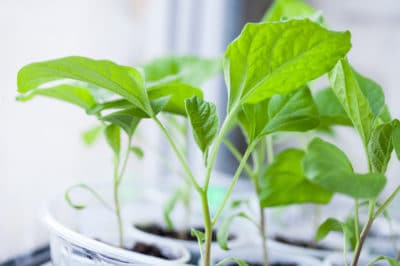Planting and Germination
Choose a variety of eggplant that produces small fruits, which also produce smaller plants. Try varieties like Little Finger or Fairy Tale.
Start seeds in 4-inch pots filled with rich, organic soil. Plant two seeds per pot and cover with 1/8 inch of soil. Lightly press down soil and water from the top. Cover the pots lightly with plastic wrap.
Place pots on top of a plant heating pad at a constant 75 degrees F. Hang a heavy-duty grow light so it sits approximately six inches above the tops of the pots. Keep the lights on 12 to 14 hours a day.
Mist the soil daily and water when the soil feels dry an inch below the surface until the seeds germinate in about 7 to 14 days. Remove and discard the plastic wrap.
Growing On
Transplant the strongest seedling in each pot into a 5-gallon container when they are one inch high. Use a fast-draining soil full of organic matter like compost and peat moss. Make sure the pots have drainage holes so water does not pool in the pot.
Before transplanting, insert a bamboo pole or trellis into the soil to support the plant as it matures.
Raise the lights as the plants grow so the lights are always about six inches above the tops of the plants. Keep the heating pad at 75 degrees F. Maintain the air temperature between 75 and 85 degrees F.
Water when the soil feels dry one inch below the surface. Mist your eggplants daily to provide them with extra humidity. If possible, run a humidifier in the room to increase humidity and counteract the dry, artificially-heated indoor air.
Feed them weekly with a balanced, water-soluble fertilizer.
Fruiting and Harvest
Use a paint brush to transfer pollen from one blossom to another. Eggplant are self-fertilizing, but you probably don’t have bees or other flying insects to help them along. Just wiggle the brush inside one blossom, then another, and then another, making sure to get them all.
Eggplants are ready to harvest when their skin is glossy and deep purple, in 90 to 100 days.
Why do the Flowers Drop Off?
- The roots dried out. Do not overwater eggplant but do not allow the roots to dry out. Water only when the soil feels dry one inch below the surface.
- Temperatures too cool. Do not allow nighttime temperatures to fall below 65 degrees F.
- Temperatures too hot. At temperatures above 95 degrees F, eggplants drop their flowers and do not produce new ones until cooler temperatures settle in.
- The flowers didn’t get properly pollinated to produce fruit.
Growing eggplants indoors can be tricky, but as long as you provide them all their environmental needs, you should be harvesting tasty fruits in no time at all.
